#why do we never talk about the Dream Lord? Toby Jones was fantastic and so intimidating even in just one episode 🙈💖
Text

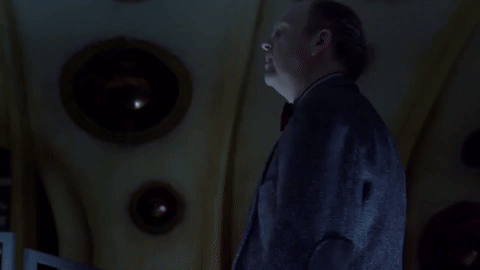




Toby Jones as The Dream Lord in Season 5 Episode 7 of Doctor Who, Amy's Choice 🐤💤
#why do we never talk about the Dream Lord? Toby Jones was fantastic and so intimidating even in just one episode 🙈💖#this is my oddly specific curse of being attracted to dudes who look like or who have played Truman Capote#doctor who#the dream lord#amy's choice#toby jones#dw#starleskatalks
9 notes
·
View notes
Text
Chapter 8 – Dream a Little Dream of Me: parallels with Doctor Who
What’s queer film and TV without a bit of Doris Day in your chapter title?
This was never intended to be a chapter by itself, but having seen @tjlcisthenewsexy’s fantastic video on Wholock parallels here X I had to start writing. Full credit for inspiration here to @tjlcisthenewsexy, who has definitely had many of these ideas independently, and I would fully recommend watching the video before you read this. I personally only really buy Moffat era Who as a direct parallel to Sherlock, largely because Moffat wrote both, but also because 2010-17 matches up exactly with our boys. Lots of people have drawn parallels between 2005’s Bad Wolf Bay scene (by Russell T Davies) and the tarmac scene – those parallels are definitely there, but I think they’re more due to common tropes in love-declaration scenes than from intent.
The Doctor Who episodes I’m largely going to be drawing on here are Amy’s Choice, Last Christmas, The Name of the Doctor and A Good Man Goes to War. Others will feature, but if you want a really strong grip on what I’m talking about, I’d recommend taking a look at all of these, or at the very least Amy’s Choice! But now – on with the show.
Time travel has always been possible in dreams. This line comes from The Name of the Doctor, which came out in 2013. The dream in question is a psychic telepathy connecting five of our main characters whilst they sleep, controlled by Madame Vastra. Much has been made of Madame Vastra being an explicit Sherlock mirror (X) with Jenny as her wife and explicit John mirror, so using a dream state to connect people across time should already ring TAB bells. But crucially, we’re not just focusing on telepathy here – we’re focusing on the ability of 19th century characters to use a dream state to connect with the 21st century. Given that we never see where River Song is connecting from, it’s safe to say that it is the 19th – 21st connection between the other characters that is important, like in TAB. The use of the word ‘always’ is really important here – it’s not saying that time travel is possible in dreams in the Whoniverse, but that it has always been possible. There’s an implication here that before time travel was invented, in a non science fiction world, dreams can still do this – and that’s what helps us to jump across to TAB.
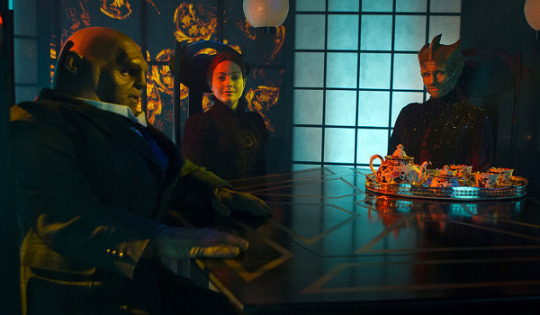
In the dream sequence in TNotD, Jenny is supposed to lock up before they go into their trance, but she forgets. Intruders break in, but because Jenny and Vastra are unconscious they can’t defend themselves and so Jenny is murdered. This is the spur for everybody to wake up, to save themselves. Pretty much all of our dream states in Doctor Who are focused on the possibility of dying in the outside world, but TNotD is the one which articulates the problem of EMP theory most specifically. Jenny, our John mirror, dies because her protector’s unconsciousness means that she can’t protect her wife. (Vastra’s Silurian abilities very much put her into the role of protector here – she could save Jenny where Jenny couldn’t save herself, and frequently does.)
Between the time travel and Jenny, then, TNoTD is probably the best framework we get set up for TAB. This came out only a few months before s3, in which EMP began, so it’s safe to say that these ideas are well-formed in Mofftiss’s heads at this stage. However, if we jump all the way back to 2010 and Amy’s Choice, we can see that this has been in the works for a lot longer.
The first point of note here is the casting of Toby Jones as the Dream Lord.
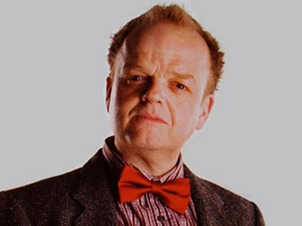

Casting the same actor to play dream merchants, knocking characters unconscious and altering their memories and psyches? The universe is rarely so lazy. Other mirrors in this episode are easy to pull out. The Doctor and Sherlock have long been read as mirrors for each other – characters who have existed for a long time and are constantly evolving through adaptation, super-intelligent loners, but in case that wasn’t obvious, Moffat went to a reasonable effort to style them very similarly when both tenures began.


Both of these are very conscious remodellings of old characters. Much was made of Matt Smith being the youngest Doctor ever (26!), and Cumberbatch’s youth set him apart from the Rathbone/Brett image in everybody’s heads. There’s something young and modern here – but both still dress like they’re slightly ‘out of their time’, which of course they are. Coming to terms with modernity is the central challenge that Sherlock is going to have to face. And then, of course, there’s the hair – instantly recognisable to the character in both cases, yet remarkably similar.
If the Doctor and Sherlock are mirrors, Amy as the Doctor’s companion should be linked to John. Amy ran away on the night before her wedding, and whilst she is reasonably happy with Rory in the long term of the series, this episode is about her making the decision between domesticity and adventure – a pretty clear link to John in s3 and 4. This episode is particularly important for TST however, because Amy is heavily pregnant in the domestic dream – but she is far from enthused, torn between domestic life with Rory and wanting to run off with the Doctor. However, I grant the similarity with Martin Freeman isn’t striking.

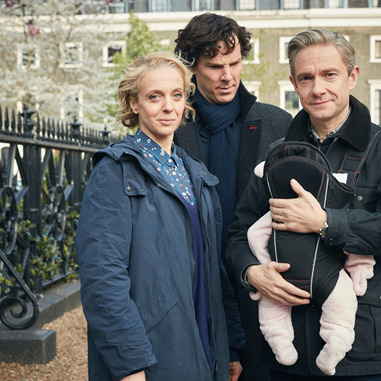
Do note, however, the similarly uncomfortable dynamic in both of these photos – hilarious.
The parallel dream!verses created broadly represent John’s dilemma from TST, and if we followed Amy’s Choice as it seems on the surface, we would end up with a pretty straight reading of TST – John spends too much time with Sherlock, they’re all in danger, Mary dies and John is suicidal because of it. Broadly speaking, this works – Rory is killed in the dream (with a really nice visual parallel to TST) and Amy crashes a bus and kills herself because she doesn’t want to live without Rory. Amy picks the domestic sphere and although it takes several more series to play out in full, this is broadly the direction the series takes us in.


In both scenes, Sherlock and the Doctor are left standing off to the right, unsure of what to do – if you watch both scenes in parallel, it’s striking. There’s a great article here talking about how the angle demonstrates the Doctor to be powerless for the first time, amongst other things. X Amy asks the Doctor what is the point of him, and John’s declaration that Sherlock has broken his vow carries similar weight – they were supposed to save them.

The title of the episode is Amy’s Choice, and this, we’re led to believe, is the moment when Amy chooses Rory. I don’t believe this. The Doctor/Rory conflict goes on for a lot longer than this, and it’s far too early in their first series to resolve it. It would leave a lot of later episodes without nearly so much tension. It’s true that Amy does have some agency in choosing – the science is questionable, as the Doctor says they’ve all tapped into some space LSD equivalent from an unmentioned offscreen adventure which has induced a mutual psychic trance, which means that we’re not sure how much agency each of the characters has in this dream. It’s not seeded, and so it sounds like a fudge – deliberately. Because a pseudoscientific explanation like this can’t explain the Dream Lord himself, Amy and Rory point out, and the Doctor admits that the Dream Lord, the architect of the dreams themselves, was actually the Doctor’s psyche. The space LSD sounded like a fudge – and Amy and Rory expose that it wasn’t just a fudge on Moffat’s part, it was a fudge on the Doctor’s part.
And, crucially, what was the first thing the Doctor said about domestic!dream, long before he realised he created it?
“Oh, you’re okay. Oh, thank God. I had a terrible nightmare about you two. That was scary. Don’t ask. You don’t want to know. You’re safe now.” X
Later, when asked how he knew that the Dream Lord was him, the Doctor merely says that no one else hates him so much. Domestic!verse, then, is a manifestation of everything that the Doctor dreads – it’s his worst nightmare, being conjured by his subconscious. That nightmare involves Amy’s suicide, Rory’s death because the Doctor can’t protect them – this maps pretty neatly onto EMP theory and TST. Although John doesn’t kill himself, he is rendered suicidal in the domestic nightmare that is left behind. As the previous chapter discusses, Sherlock not being able to protect John is definitely a nightmare, but the nightmare also maps onto reality – John is suicidal, but he’s struggling to work out why, so he has to construct it through a heterosexual lens. John’s potential death and love for Mary are the two things that form the worst nightmare in both dreams, and the nightmarish sense is highlighted in TST by the deep waters metaphor.
At the very end of the episode, the Doctor’s reflection is still the Dream Lord, suggesting that this isn’t some psychic drug phenomenon, an explanation which was frankly crap. The Doctor’s dark side is still inside him. This feels like an allegory for mental illness, and mental illness crops up aplenty in Moffat’s depictions of the Doctor, particularly the later we get – the seeds of it are here. Again, although Sherlock is being killed rather than killing himself, we have seen the suicidal side of him before and it is made clear in TAB that his opinion of himself is low. EMP s4 is about him coming to terms with how he views himself, and the cognitive dissonance that we see in Amy’s Choice is a nice separation of the psyche in two that foreshadows the immense splintering that’s going to come in EMP, but particularly between John, Mycroft and Eurus.
Another nice parallel between s4 and Amy’s Choice is the idea of predictability. Way before we know that this is the Doctor’s dream, the Doctor displays a remarkable ability to finish what the Eknodines say before they do, an ability which becomes an obvious hint in hindsight. Moving over to TLD, Sherlock has similarly ridiculous powers to predict what other people will do; because this underpins TLD, it jumps out as being something that rings very false to me, almost like a parody of who Sherlock Holmes is meant to be, and so we should pay attention to it. An uncanny ability to predict what others will do – yup, that’s a dream world.
One key similarity that Amy’s Choice has with EMP theory is that a false dream premise is set up in both. Amy’s Choice suggests that there are two worlds, and only one is a dream; their survival depends on recognising which is the real one. This is, of course, a lie – both worlds are dreamed, and that false premise is created to trap them in the Doctor’s psyche, presumably until the Doctor dies (although the threat is never clearly explained). TAB sets up a real world in the form of the modern day and a false Victorian age, but the supernatural graveyard scene is the first hint that the reality/dream binary is not real, just like Amy’s Choice. This one scene is not an anomaly – the chronology of the ‘man out of my time’ scene coming after Sherlock gets off the tarmac suggests that such mixing is still going on, and we shouldn’t trust our senses. In case that point needed hammering any more, however, Steven Moffat gave us A Good Man Goes To War.
This episode is the culmination of a series in which Amy is actually an almost-person, and Amy has been dreaming all of their adventures with a flesh avatar actually having them with Rory and the Doctor. Here it is Amy, rather than the Doctor, who is dreaming, which is a little ambiguous, but there are two key aspects that parallel Amy’s Choice. The first is that, like Amy’s Choice, the flesh avatar/dream person threat doesn’t just go away. These words of Madame Kovarian are extremely important:
Fooling you once was a joy, but fooling you twice, the same way? It’s a privilege. X
Exactly what the Dream Lord does in Amy’s Choice. Furthermore, although there’s a later meta in blindness across Doctor Who and Sherlock which at some stage really needs writing, many people have made the point that Sherlock is associated with blindness throughout series 4, and so we should note that the architect of the dream people/flesh avatars is Madame Kovarian, better known (and usually credited) as the Eyepatch Lady. However, there’s one other key message they’re giving us, which comes at the end of the clip linked above – the baby’s not real. Both Amy’s Choice and A Good Man Goes To War feature Amy’s child, and in both cases the plot revolves around the emotional recognition that that world isn’t real. Given that we know that Amy is a John mirror, and that her choice between the domestic and the adventurous is consistently paralleled to John’s choice in Sherlock, this is a pretty huge indicator that something is up with Rosie even if we didn’t know it already. Indeed, the cot and mobile that the child has in Amy’s Choice are similar to Rosie’s. That baby never stood a chance.


The last episode I want to briefly invoke is Last Christmas. If we’re looking for dreams, this episode really goes above and beyond. The premise is that there is an alien species called the dream crab which latches onto your face and dissolves your brain whilst putting you in a dream so that you don’t notice. To make this more confusing, it often places dreams within dreams to confuse you – whilst you’re dying. This episode came out on Christmas Day 2014, so a year after series 3 aired but before TAB, so in Sherlock-time we’ve just entered the mind palace. The title, Last Christmas, is pretty helpful here I think – of course it has relevance within the episode, but this episode should also get us thinking about what was going on this time last year, when Sherlock was airing.
We’re no stranger to dreams within dreams at this stage, but it’s interesting how the saving-the-companion vibe is still going strong here. Ostensibly, that’s not what the episode is about at all – it’s a classic everyone-trapped-on-a-base-working-together episode, but the last five minutes tacked on the end suggests that it’s far more about the Doctor’s relationship with Clara, the episode’s companion, than one might think. In this clip (X) the Doctor thinks he’s broken out of the final dream but goes back to visit Clara and realises that she is now old, and that he’s missed her life. It culminates in him apologising for getting it wrong, for not coming for her in time, for failing her; we get more of this with Clara’s actual death later in the show, but given that it’s a kid’s show and Christmas, this scene is a touch lighter than that. It’s then that Father Christmas comes in to tell the Doctor that he’s still dreaming, he can still save her – and his first word when he wakes up is “Clara”. None of the others trapped in the dream have needed his help to wake from the vision and survive; Clara, who as the companion is our John mirror, specifically needs saving, and the Doctor needs to wake up from his dream within a dream to do that.

Nick Frost’s appearance as Father Christmas gave us all a good laugh, but he was also used as the indicator that the world we were perceiving was a dream world. This was made a bit of a joke of early in the episode – in a sci-fi world like this, are we seriously looking for what’s not realistic as the code to crack the dream? The exact same joke is made in Amy’s Choice, and here we’re hitting a pretty silly version of the show where they joke that just about the only character who can’t be real is Father Christmas. These hints about looking for what’s not real, though, should be taken as just that – hints. From the emergence of ‘something’s fucky’ theories early on in s4, this has been the abiding reasoning for the various forms of EMP theory that have sprung up, and they’re not wrong. However, if I had to put my money on a figure like Santa Claus, something iconic which functions as a kind of dream thermometer, I’d be guessing:
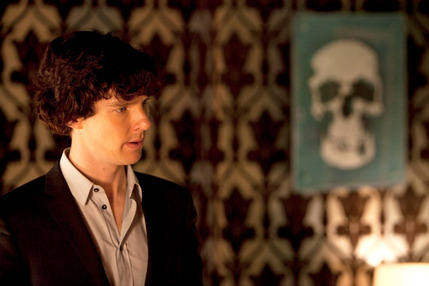
You were there before me. The fucky skull that glows, almost like a warning that this is too mad. Crucially, in Last Christmas they explain that Santa is a warning that your brain is sending you, picking the most unbelievable thing possible so that you know you’re trapped, dying in your brain. Santa Claus? Well, it’s a kid’s show, and it’s Christmas. But if I were picking a dream siren to tell me I was dying, I like to think that my subconscious would pick the glowing skull on the wall; without explanation, it’s an awful lot more direct.
There is more reference than necessary made to dream crabs making one blind, and between Madame Kovarian and the blind Doctor in the later dream episode Extremis, there’s a lot more to unpack there, but I’m going to leave that for sometime down the line, or for someone else to jump into if they would like. I also want to throw out a thought I haven’t quite come to terms with yet – the elephant in the room in Amy’s Choice. Arwel Wyn Jones would be proud of the script for Amy’s Choice – twice, it mentions the elephant in the room, and so I feel I have to do the same. The first time, you could blink and miss it – the Doctor calls pregnant Amy ‘elephanty’. But the second time, we get this exchange:
DOCTOR: Now, we all know there’s an elephant in the room.
AMY: I have to be this size, I’m having a baby.
DOCTOR: No, no. The hormones seem real, but no. Is nobody going to mention Rory’s ponytail? You hold him down, I’ll cut it off? X
The elephant in the room – that the baby’s not real? Possibly, but not what we normally take it to mean. Rory’s ponytail also has not shaving for Sherlock Holmes vibes, but again it’s not quite concrete in my mind. These little bits at the end aren’t quite tied up, and I would love to hear what people have to say about them. That, however, is for another day! The next chapter in this series will be jumping back into episode-by-episode analysis with TLD – see you there.
#emp theory#wholock#tjlc#thewatsonbeekeepers#meta#my meta#mine#bbc sherlock#chapter eight: dream a little dream of me#tjlc is real#johnlock#sherlock holmes#doctor who#steven moffat#mark gatiss
12 notes
·
View notes